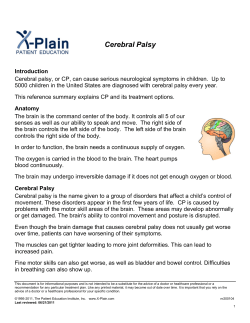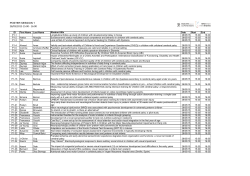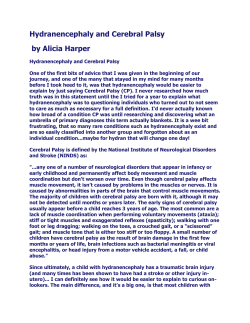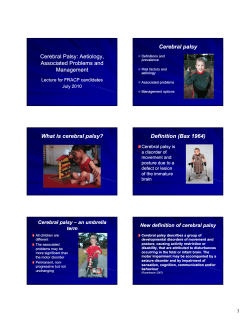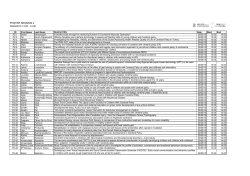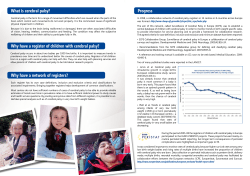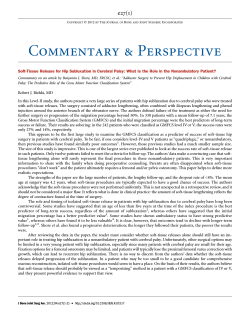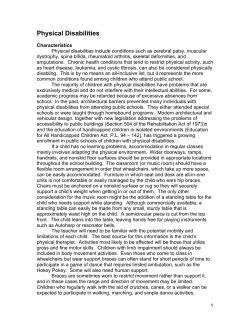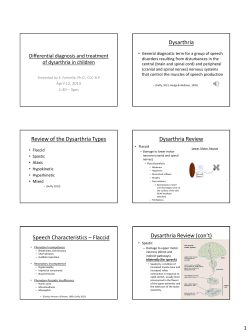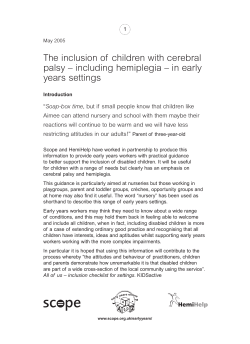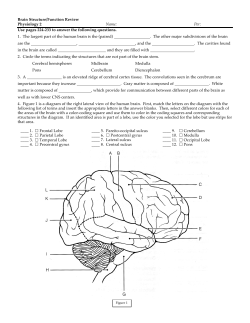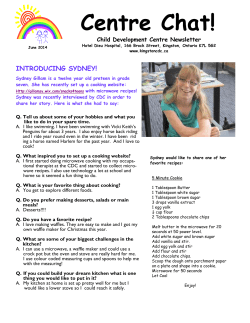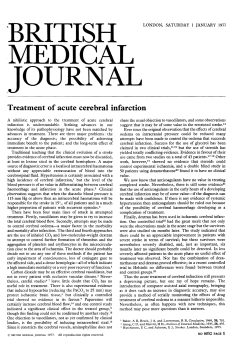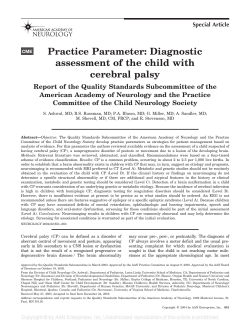
Understanding Cerebral Palsy Super Duper Handy Handouts!
Super Duper® Handy Handouts!® Number 126 Understanding Cerebral Palsy By Lisa Priddy, SLP-CCC and Tara Calder, OT What Is Cerebral Palsy? Cerebral Palsy (CP) is a disorder that stems from injury to the parts of the brain that control motor movements. This means that a child with cerebral palsy has difficulty controlling the muscles in his/her body, may have limited motor skills, speech difficulties, and/or decreased cognition and learning disabilities. Estimates suggest that 50% of children diagnosed with cerebral palsy have some form of vision deficit. The injury may happen before birth, during delivery, or in the months after birth. Approximately 500,000 people in the United States have some form of cerebral palsy. There Are Three Main Types of Cerebral Palsy Athetoid cerebral palsy affects muscle tone, causing it to fluctuate from low to normal and sometimes high. Children often have random involuntary movements of their faces, arms, and upper bodies (and to a lesser extent lower extremities). These children also have difficulty holding their trunks in a steady, upright position and often need external trunk support to maintain balance. For most of these children, it takes a lot of work and concentration to complete tasks. For example, reaching for a toy and getting it in their hand in the correct spot is difficult due to tone fluctuations and involuntary movements. This type of cerebral palsy occurs in approximately 20% of all cases. Ataxic cerebral palsy affects balance and depth perception. Children with ataxic cerebral palsy have poor coordination of their movements and have tremors or “shakiness” when engaging in fine motor tasks such as writing. Some children with this type of cerebral palsy also have low muscle tone. This is the rarest type of cerebral palsy, occurring in less than 10% of all cases. Spastic cerebral palsy affects the body with tight muscle movements and exaggerated reflexes. These children often have stiff jerky movements with limited range of motion because of their tight muscles. They may also have trouble moving from one position to another or letting go of something in their hand. This is the most common form of cerebral palsy, occurring in approximately 70% of all cases. About 30% of children with this type of cerebral palsy also have one of the other types referred to above. Some medical professionals consider this a fourth type of cerebral palsy and often refer to it as "Mixed." Spastic cerebral palsy is further subdivided by region of the body affected. These include: Hemiplegia – one side of the body affected Diplegia – mainly affecting the legs or the lower body Quadriplegia – all four limbs and often the head and trunk are affected Even though two children might have a diagnosis of cerebral palsy, their abilities and needs may be very different from one another. © 2007 Super Duper® Publications• www.superduperinc.com Super Duper® Handy Handouts!® Number 126 Is Cerebral Palsy Curable? Cerebral palsy is permanent, not curable, and affects every child differently. One child with severe cerebral palsy may have difficulty walking independently while another child walks with only a slight limp. Regardless, children who receive treatment early have a better chance of learning new ways to accomplish tasks that may be challenging for them such as walking, feeding, and dressing. Children with cerebral palsy may benefit from different types of intervention such as: Speech therapy (ST) — This helps the child develop his/her communication skills by improving specific language and articulation skills and/or providing alternative methods of communication such as a communication device. Physical therapy (PT) — This helps the child develop stronger muscles in the body for sitting, walking, and keeping his/her balance and/or providing adaptive equipment to assist the child with sitting, walking, and balance. Occupational therapy (OT) — This helps the child to participate in everyday activities such as dressing, eating, playing, and doing schoolwork by improving specific skills such as fine motor skills and/or providing adaptive equipment and techniques to increase a childʼs independence. Medical intervention includes medication to control tone and surgical intervention to release tight muscles and fixed joints. Stimulating Toys and Activities The multiple disabilities that accompany cerebral palsy can interfere with a childʼs ability to participate in everyday tasks such as play. Finding appropriate and stimulating toys for children with CP can sometimes be difficult. Toys that concentrate on what the child can do rather that what he/she canʼt promotes positive participation and may help decrease frustration. Often children with cerebral palsy benefit from materials that have been adapted to require less manipulation, such as switch adapted toys. Consult with your therapist to help you determine what toy or adaptations best meet your childʼs specific needs. More information on cerebral palsy is available at United Cerebral Palsy http://www.ucp.org/ . Resources http://www.ninds.nih.gov/disorders/cerebral_palsy/cerebral_palsy.htm http://www.cerebralpalsyfacts.com http://www.nichcy.org/pubs/factshe/fs2txt.htm © 2007 Super Duper® Publications • www.superduperinc.com
© Copyright 2025
